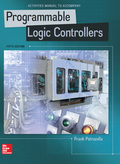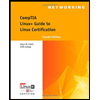
EBK ACTIVITIES MANUAL FOR PROGRAMMABLE
5th Edition
ISBN: 8220102795983
Author: Petruzella
Publisher: YUZU
expand_more
expand_more
format_list_bulleted
Question
Chapter 7, Problem 1RQ
Program Plan Intro
- The main purpose of mechanical timing relays is to delay the opening and closing of contacts for circuit control.
- Its operation is almost similar to that of a control relay.
- The only difference is that the contacts of a mechanical timing relay are used to operate at a preset time interval, that is, after the coil is energized or de-energized.
- One example for mechanical timing relay is Pneumatic timing relay.
Expert Solution & Answer
Explanation of Solution
Difference between timed and instantaneous contacts of a mechanical timing relay:
| Timed contacts | Instantaneous contacts |
| Timed contacts change its state only when the time is lapsed. | Instantaneous contacts change its state as long as the power is supplied to the timer coil. |
| Timed contacts are designed to delay the process control. | Instantaneous contacts are designed to hold or seal the contacts in a control circuit. |
| When a coil is energized, these contacts delay from opening or closing. | When a coil is energized, this contact closes off open immediately. |
Want to see more full solutions like this?
Subscribe now to access step-by-step solutions to millions of textbook problems written by subject matter experts!
Students have asked these similar questions
A Dia file has been created for you to extend and can be found on Company.dia represents a completed ER schema which, models some of the information implemented in the system, as a starting point for this exercise.
Understanding the ER schema for the Company database.
To demonstrate that you understand the information represented by the schema, explain using EMPLOYEE, DEPARTMENT, PROJECT and DEPENDENT as examples:
attributes, entities and relationships
cardinality & participation constraints on relationships
You should explain questions a and b using the schema you have been given to more easily explain your answers.
Creating and Extending Entity Relationship (EER) Diagrams.
To demonstrate you can create entity relationship diagrams extend the ER as described in Company.dia by modelling new requirements as follows:
Create subclasses to extend Employee. The employee type may be distinguished further based on the job type (SECRETARY, ENGINEER, MANAGER, and TECHNICIAN) and based…
Computer programs can be very complex, containing thousands (or millions) of lines of code and performing millions of operations per second. Given this, how can we possibly know that a particular computer program's results are correct? Do some research on this topic then think carefully about your response. Also, explain how YOU would approach testing a large problem. Your answer must be thoughtful and give some insight into why you believe your steps would be helpful when testing a large program.
Could you fix this? My marker has commented, What's missing? The input list is the link below.
https://gmierzwinski.github.io/bishops/cs321/resources/CS321_Assignment_1_Input.txt
result.put(true, dishwasherSum); result.put(false, sinkSum); return result; }}
Chapter 7 Solutions
EBK ACTIVITIES MANUAL FOR PROGRAMMABLE
Ch. 7 - Prob. 1RQCh. 7 - Prob. 2RQCh. 7 - Prob. 3RQCh. 7 - Prob. 4RQCh. 7 - a. What are the two methods commonly used to...Ch. 7 - Prob. 6RQCh. 7 - Prob. 7RQCh. 7 - Prob. 8RQCh. 7 - For a TOF timer: a. When is the enable bit of a...Ch. 7 - Explain what each of the following quantities...
Ch. 7 - State the method used to reset the accumulated...Ch. 7 - Study the ladder logic program in Figure 7-40 and...Ch. 7 - Study the ladder logic program in Figure 7-42, and...Ch. 7 - Prob. 6PCh. 7 - Prob. 7PCh. 7 - Prob. 8PCh. 7 - Prob. 9PCh. 7 - Prob. 10PCh. 7 - Prob. 11PCh. 7 - Prob. 13PCh. 7 - When the lights are turned off in a building, an...
Knowledge Booster
Similar questions
- PLEG136: Week 5 Portofolio Project Motion to Compelarrow_forwardB A E H Figure 1 K Questions 1. List the shortest paths between all node pairs. Indicate the number of shortest paths that pass through each edge. Explain how this information helps determine edge betweenness. 2. Compute the edge betweenness for each configuration of DFS. 3. Remove the edge(s) with the highest betweenness and redraw the graph. Recompute the edge betweenness centrality for the new graph. Explain how the network structure changes after removing the edge. 4. Iteratively remove edges until at least two communities form. Provide step-by-step calculations for each removal. Explain how edge betweenness changes dynamically during the process. 5. How many communities do you detect in the final step? Compare the detected communities with the original graph structure. Discuss whether the Girvan- Newman algorithm successfully captures meaningful subgroups. 6. If you were to use degree centrality instead of edge betweenness for community detection, how would the results change?arrow_forwardUnit 1 Assignment 1 – Loops and Methods (25 points) Task: You are working for Kean University and given the task of building an Email Registration System. Your objective is to generate a Kean email ID and temporary password for every new user. The system will prompt for user information and generate corresponding credentials. You will develop a complete Java program that consists of the following modules: Instructions: 1. Main Method: ○ The main method should include a loop (of your choice) that asks for input from five users. For each user, you will prompt for their first name and last name and generate the email and password by calling two separate methods. Example о Enter your first name: Joe Enter your last name: Rowling 2.generateEmail() Method: This method will take the user's first and last name as parameters and return the corresponding Kean University email address. The format of the email is: • First letter of the first name (lowercase) + Full last name (lowercase) +…arrow_forward
- (Using R language)arrow_forwardAfter our initial deployment for our ML home based security system, the first steps we took to contribute further to the project, we conducted load testing, tested and optimize for low latency, and automated user onboarding. What should be next?arrow_forwardWhy investing in skills and technology is a critical factor in the financial management aspect of system projects.arrow_forward
arrow_back_ios
SEE MORE QUESTIONS
arrow_forward_ios
Recommended textbooks for you
 Systems ArchitectureComputer ScienceISBN:9781305080195Author:Stephen D. BurdPublisher:Cengage Learning
Systems ArchitectureComputer ScienceISBN:9781305080195Author:Stephen D. BurdPublisher:Cengage Learning EBK JAVA PROGRAMMINGComputer ScienceISBN:9781305480537Author:FARRELLPublisher:CENGAGE LEARNING - CONSIGNMENT
EBK JAVA PROGRAMMINGComputer ScienceISBN:9781305480537Author:FARRELLPublisher:CENGAGE LEARNING - CONSIGNMENT Principles of Information Systems (MindTap Course...Computer ScienceISBN:9781285867168Author:Ralph Stair, George ReynoldsPublisher:Cengage Learning
Principles of Information Systems (MindTap Course...Computer ScienceISBN:9781285867168Author:Ralph Stair, George ReynoldsPublisher:Cengage Learning Enhanced Discovering Computers 2017 (Shelly Cashm...Computer ScienceISBN:9781305657458Author:Misty E. Vermaat, Susan L. Sebok, Steven M. Freund, Mark Frydenberg, Jennifer T. CampbellPublisher:Cengage Learning
Enhanced Discovering Computers 2017 (Shelly Cashm...Computer ScienceISBN:9781305657458Author:Misty E. Vermaat, Susan L. Sebok, Steven M. Freund, Mark Frydenberg, Jennifer T. CampbellPublisher:Cengage Learning Fundamentals of Information SystemsComputer ScienceISBN:9781305082168Author:Ralph Stair, George ReynoldsPublisher:Cengage Learning
Fundamentals of Information SystemsComputer ScienceISBN:9781305082168Author:Ralph Stair, George ReynoldsPublisher:Cengage Learning CompTIA Linux+ Guide to Linux Certification (Mind...Computer ScienceISBN:9781305107168Author:Jason EckertPublisher:Cengage Learning
CompTIA Linux+ Guide to Linux Certification (Mind...Computer ScienceISBN:9781305107168Author:Jason EckertPublisher:Cengage Learning

Systems Architecture
Computer Science
ISBN:9781305080195
Author:Stephen D. Burd
Publisher:Cengage Learning

EBK JAVA PROGRAMMING
Computer Science
ISBN:9781305480537
Author:FARRELL
Publisher:CENGAGE LEARNING - CONSIGNMENT

Principles of Information Systems (MindTap Course...
Computer Science
ISBN:9781285867168
Author:Ralph Stair, George Reynolds
Publisher:Cengage Learning

Enhanced Discovering Computers 2017 (Shelly Cashm...
Computer Science
ISBN:9781305657458
Author:Misty E. Vermaat, Susan L. Sebok, Steven M. Freund, Mark Frydenberg, Jennifer T. Campbell
Publisher:Cengage Learning

Fundamentals of Information Systems
Computer Science
ISBN:9781305082168
Author:Ralph Stair, George Reynolds
Publisher:Cengage Learning

CompTIA Linux+ Guide to Linux Certification (Mind...
Computer Science
ISBN:9781305107168
Author:Jason Eckert
Publisher:Cengage Learning